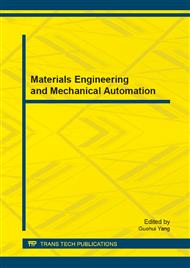[1]
Chen Huifang, Hiroshi Mineno, Tadanori Mizuno. Adaptive data aggregation scheme in clustered wireless sensor networks[J]. Computer Communications, Vol. 31, No. 15, pp.3579-3585, (2008).
DOI: 10.1016/j.comcom.2008.06.011
Google Scholar
[2]
Zhou S, Lin Y, Zhang J. A Wavelet Data Compression Algorithm Using Ring topology for Wireless Sensor Networks[J]. Journal of Software, Vol. 18, No. 3, pp.669-680, (2007).
DOI: 10.1360/jos180669
Google Scholar
[3]
Zheng Jun, Wang Pu, Li Cheng. Distributed data aggregation using Slepian-Wolf coding in cluster-based wireless sensor networks[J]. IEEE Trans on Vehicular Technology, Vol. 59, No. 5, pp.2564-2574, (2010).
DOI: 10.1109/tvt.2010.2042186
Google Scholar
[4]
Xu Xiaohua, Li xiangyang, Mao Xufei, et al. A Delay-Efficient Algorithm for Data Aggregation in Multi-Hop Wireless Sensor Networks[J]. IEEE Transactions on Parallel and Distributed Systems, Vol. 22, No. 1, pp.163-175, (2011).
DOI: 10.1109/tpds.2010.80
Google Scholar
[5]
YU Bo, Li Jianzhong, Li Yingshu. Distributed data aggregation scheduling in wireless sensor networks[C]. Proceedings of the 28th Conference on Computer Communications, pp.2159-2167, (2009).
Google Scholar
[6]
FAN Y C, CHEN A L P. Efficient and robust sensor data aggregation using linear counting sketches[J]. IEEE Trans on Parallel and Distributed Systems, Vol. 21, No. 11, pp.1675-1691, (2010).
DOI: 10.1109/tpds.2010.33
Google Scholar
[7]
Liao W H, Kao Yucheng, Fan C M. Data aggregation in wireless sensor networks using ant colony algorithm[J]. Journal of Network and Computer Applications, Vol. 31, No. 4, pp.387-401, (2008).
DOI: 10.1016/j.jnca.2008.02.006
Google Scholar
[8]
Singh A, Rossi A. A genetic algorithm based exact approach for lifetime maximization of directional sensor networks[J]. Ad Hoc Networks, Vol. 11, No. 3, pp.1006-1021, (2013).
DOI: 10.1016/j.adhoc.2012.11.004
Google Scholar
[9]
Kemal Akkaya, Murat Demirbas, Aygun R S. The impact of data aggregation on the performance of wireless sensor networks[J]. Wireless Communications & Mobile Computing, Vol. 8, No. 2, pp.171-193, (2008).
DOI: 10.1002/wcm.454
Google Scholar
[10]
Suat O, Yang Xiao. Secure data aggregation in wireless sensor networks: a comprehensive overview[J]. The International Journal of Computer and Telecommunications Networking, Vol. 53, No. 12, pp.2022-2037, (2009).
DOI: 10.1016/j.comnet.2009.02.023
Google Scholar
[11]
Zhu T, Lin Y, Zhou S, et al. Adaptive Multiple-Modalities Data Compression Algorithm Using Wavelet for Wireless Sensor Networks[J]. Journal on Communications, Vol. 30, No. 3, pp.48-54, (2009).
Google Scholar
[12]
Chen Suisheng, Lu Jiangang. An Adaptive Multiple-Modality Sensor Network Data Compression Algorithm Based on Lifting Wavelet and Polynomial Fitting[J]. Chinese Journal of Sensors and Actuators, Vol. 26, No. 4, pp.550-557, (2013).
Google Scholar


